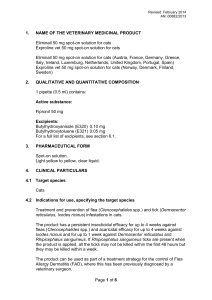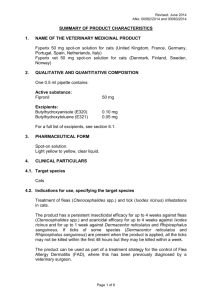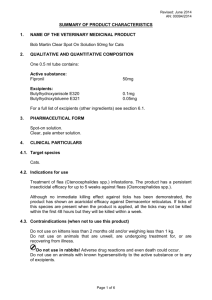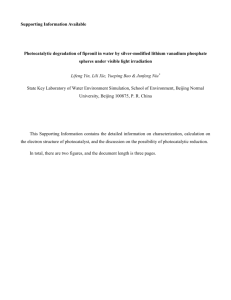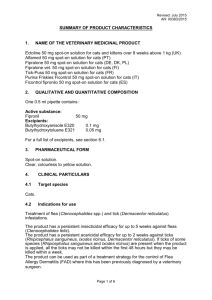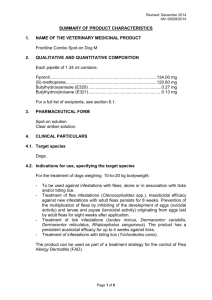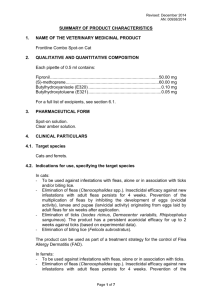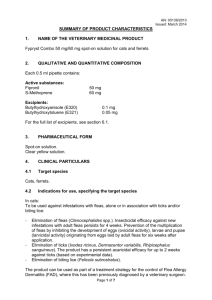United Kingdom Veterinary Medicines Directorate Woodham Lane
advertisement
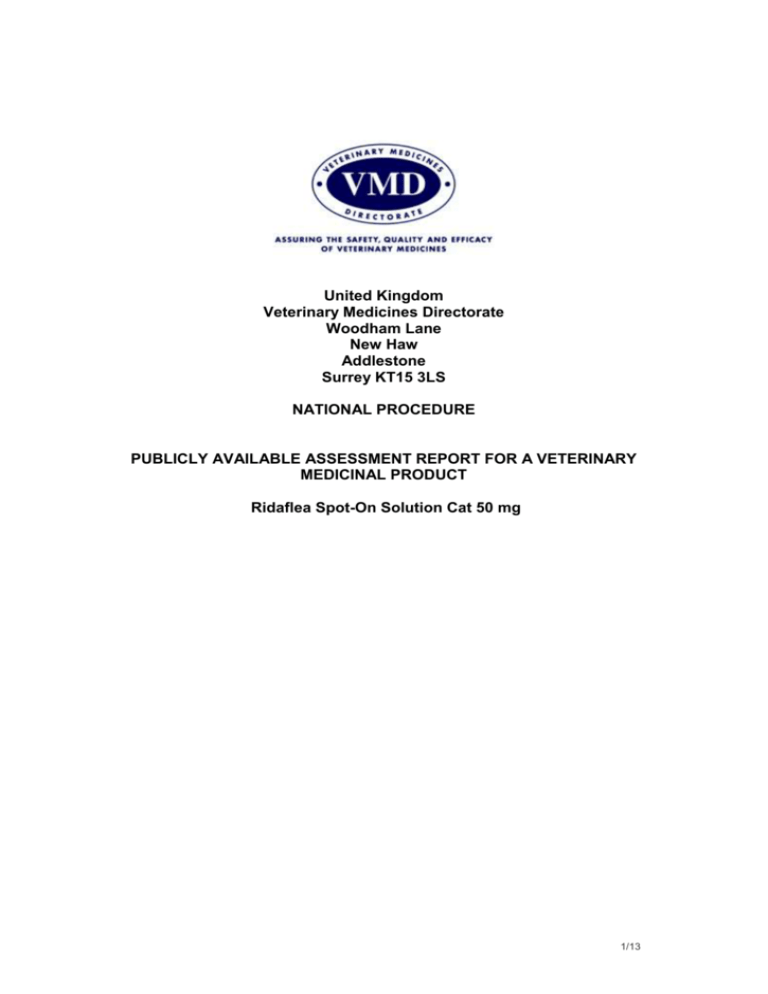
United Kingdom Veterinary Medicines Directorate Woodham Lane New Haw Addlestone Surrey KT15 3LS NATIONAL PROCEDURE PUBLICLY AVAILABLE ASSESSMENT REPORT FOR A VETERINARY MEDICINAL PRODUCT Ridaflea Spot-On Solution Cat 50 mg 1/13 Ridaflea Spot-On Solution Cat 50 mg EU Pharmaceuticals Ltd Application for National Procedure Publicly Available Assessment Report MODULE 1 PRODUCT SUMMARY Name, strength and pharmaceutical form Ridaflea Spot-On Solution Cat 50 mg Applicant EU Pharmaceuticals Ltd. 37 Geraldine Road London SW18 2NR UK Active substance Fipronil ATC Vetcode QP53AX15 Target species Cats Indication for use Treatment of flea (Ctenocephalides spp.) infestations. The product has a persistent insecticidal efficacy for up to 5 weeks against fleas (Ctenocephalides spp.). Although no immediate killing effect against ticks has been demonstrated, the product has shown an acaricidal efficacy against Dermacentor reticulatus. If ticks of this species are present when the product is applied, all the ticks may not be killed within the first 48 hours but they will be killed within a week. The product can be used as part of a treatment strategy for Flea Allergic Dermatitis, where this has been previously diagnosed by a veterinary surgeon. 2/13 Ridaflea Spot-On Solution Cat 50 mg EU Pharmaceuticals Ltd Application for National Procedure Publicly Available Assessment Report MODULE 2 The Summary of Product Characteristics (SPC) for this product is available on the Veterinary Medicines Directorate website (www.vmd.defra.gov.uk) 3/13 Ridaflea Spot-On Solution Cat 50 mg EU Pharmaceuticals Ltd Application for National Procedure Publicly Available Assessment Report MODULE 3 PUBLIC ASSESSMENT REPORT Legal basis of original application Generic hybrid application in accordance with Article 13 (3) of Directive 2001/82/EC as amended. I. SCIENTIFIC OVERVIEW This application was submitted according to Article 13 (3) for ‘hybrid’ products. For this type of application, bioequivalence has not been demonstrated by bioavailability studies but by clinical equivalence. The product was developed as generics of Frontline Spot On, produced by Merial Animal Health Ltd. The product is indicated for the treatment of flea (Ctenocephalides spp) in cats. The product has a persistent insecticidal efficacy for up to 5 weeks against fleas. No immediate killing effect against ticks has been demonstrated. However, the product has shown an acaricidal efficacy against Dermacentor reticulates. If ticks of this species are present when the product is applied, all the ticks may not be killed within the first 48 hours but they will be killed within a week. The products can be used as part of the treatment for the control Flea Allergy Dermatitis, where this has been diagnosed by a veterinary surgeon. The product is produced and controlled using validated methods and tests which ensure the consistency of the products released on the market. It has been shown that the product can be safely used in the target species, the slight reactions observed are indicated in the SPC.1 The product is safe for the user, and for the environment, when used as recommended. Suitable warnings and precautions are indicated in the SPC. The efficacy of the product was demonstrated according to the claims made in the SPC. The overall benefit/risk analysis is in favour of granting a marketing authorisation. II. QUALITY ASPECTS A. Composition The product contains fipronil as active substance and excipients butylhydroxyanisole E320, butylhydroxytoluene E321, benzyl alcohol and diethylene glycol monoethyl ether. The container/closure system consists of white opaque, pink translucent or green translucent polypropylene single-dose pipettes containing an extractable volume of 0.5 ml packaged in a clear PVC blister closed by heat sealing with aluminium foil and placed in a carton box or blister card. Blister cards or boxes 1 SPC – Summary of Product Characteristics. 4/13 Ridaflea Spot-On Solution Cat 50 mg EU Pharmaceuticals Ltd Application for National Procedure Publicly Available Assessment Report contain 1, 2, 3, 4, 6, 8, 9, 10, 12, 15, 18, 20, 21, 24, 30, 60, 90 or 150 pipettes. The particulars of the containers and controls performed are provided and conform to the regulation. The choice of the formulation is justified. B. Method of Preparation of the Product The product is manufactured fully in accordance with the principles of good manufacturing practice from a licensed manufacturing site. Process validation data on the product have been presented in accordance with the relevant European guidelines. C. Control of Starting Materials The active substance is fipronil which is almost unabsorbed through the skin and the formulation is designed to deposit the active substance easily onto the animal. There are four excipients used in the formulation and each has been used previously in veterinary medicines. The active substance specification is considered adequate to control the quality of the material. Batch analytical data demonstrating compliance with this specification have been provided. All the excipients used in the final product have monographs in the Ph. Eur. and each comply with the requirements of the current edition of the Ph. Eur. D. Specific Measures concerning the Prevention of the Transmission of Animal Spongiform Encephalopathies There are no substances within the scope of the TSE Guideline present or used in the manufacture of this product. E. Control on intermediate products Not applicable. F. Control Tests on the Finished Product The finished product specification controls the relevant parameters for the pharmaceutical form. The tests in the specification, and their limits, have been justified and are considered appropriate to adequately control the quality of the product. Satisfactory validation data for the analytical methods have been provided. 5/13 Ridaflea Spot-On Solution Cat 50 mg EU Pharmaceuticals Ltd Application for National Procedure Publicly Available Assessment Report Batch analytical data from the proposed production sites have been provided demonstrating compliance with the specification. G. Stability Stability data on the active substance have been provided in accordance with applicable European guidelines, demonstrating the stability of the active substance when stored under the approved conditions. Stability data on the finished product have been provided in accordance with applicable European guidelines, demonstrating the stability of the product throughout its shelf life when stored under the approved conditions. H. Genetically Modified Organisms Not applicable. J. Other Information Shelf life of the product as packaged for sale: 2 years. Store below 25oC in a dry place in the original packaging. III. SAFETY AND RESIDUES TOXICOLOGICAL) III.A Safety Testing ASSESSMENT (PHARMACO- Pharmacological Studies Pharmacodynamics Published data were submitted for this section, which were also relevant to Part IV, Clinical Aspects. Fipronil is a phenylpyrazole which blocks insect gammaamino butyric acid receptors, compromising the action of chloride ions. The ensuing uncontrolled central nervous system activity results in the death of the organism. Fipronil is also thought to have an effect on glutamate-activated chloride channels, which are not present in vertebrates. A metabolite of fipronil, fipronil sulfone is also considered to have an effect. Pharmacokinetics Published data were submitted for this section, which were also relevant to Part IV, Clinical Aspects. Subsequent to topical application in the cat, fipronil spreads over the skin via translocation, being stored in the oil glands of the skin and shed with the hair and sebum. The concentration of the active substance decreases over time. 6/13 Ridaflea Spot-On Solution Cat 50 mg EU Pharmaceuticals Ltd Application for National Procedure Publicly Available Assessment Report Toxicological Studies Single Dose Toxicity Published data were submitted for this section. A review of chronic and subchronic toxicity found that technical grade fipronil is acutely toxic to mammals via the inhalation and oral routes of exposure. Side effects include a hunched posture, abnormal gait, diarrhoea and piloerection. Further data stated that mild dermal and eye irritation occurred, but that the active substance was not a sensitiser in the guinea pig sensitisation test. Additional data showed that fipronil caused neurotoxicity in rats at a NOEL2 of 0.5 mg/ml. Two other studies showed NOAELs3 of 5.0 mg/kg, and 2.5 mg/kg and 7.5 mg/kg respectively. Repeated Dose Toxicity Data provided showed that in rats, repeated dosing of fipronil caused seizure, inappetance, decrease bodyweight, liver dysfunction and changes in blood cell biochemistry. In dogs, fipronil toxicity caused neurotoxicological signs and low bodyweight. Other Studies Reproductive Toxicity Published evidence of reproductive toxicity was seen, with a reproductive toxicity for rats described as being at a NOEL of 2.54 mg/kg/day and 2.74 mg/kg/day, and a developmental toxicity study where a NOEL of 20 mg/kg was displayed with a maternal toxicity of 4/mg/kg/day. The SPC4 states that ‘Studies have not been carried out with this product in pregnant and lactating bitches. Use in pregnancy and lactation only in accordance with professional veterinary advice and a benefit/risk assessment.’ Carcinogenicity and Mutagenicity Suitable references were submitted with regard to these topics. Special Studies No reports of immunotoxicity were found in published literature. Fipronil was found to be developmentally neurotoxic in repeat dose studies in rats and dogs. NOEL – No Observable Effect Limit. NOAEL – No Observable Adverse Effect Limits. 4 SPC – Summary of Product Characteristics. 2 3 7/13 Ridaflea Spot-On Solution Cat 50 mg EU Pharmaceuticals Ltd Application for National Procedure Publicly Available Assessment Report Observations in Humans In most cases, exposure to fipronil in reported cases caused vomiting, orophayngeal pain, abdominal pain, coughing, headache and drowsiness. Symptoms resolved spontaneously. Microbiological Studies Studies on Metabolites, Impurities, Other Substances and Formulation Suitable reference data were submitted. Specific eye and skin irritation studies for fipronil were not submitted, and this was considered acceptable as the proposed products contain well-known spot on formulations. Data were also submitted with regard to the irritant properties of the excipients. The SPC contains suitable warnings. User Safety A satisfactory user risk assessment was provided. It was established that the products should not pose any greater risk to the user than the reference product, when used as described on the SPC and product literature. The following warnings and precautions are listed on the SPC and product literature: This product can cause mucous membrane and eye irritation. Therefore, contact between the product and the mouth or eyes should be avoided. In the case of accidental eye contact, immediately and thoroughly flush the eyes with water. If eye irritation persists seek medical advice and show the package leaflet or the label to the physician. Avoid contents coming into contact with the fingers. If this occurs, wash hands with soap and water. Wash hands after use. Do not smoke, drink or eat during application. Animals or people with a known hypersensitivity to fipronil or any of the other ingredients should avoid contact with the product. Treated animals should not be handled until the application site is dry, and children should not be allowed to play with treated animals until the application site is dry. It is therefore recommended that animals are not treated during the day, but should be treated during the early evening, and that recently treated animals should not be allowed to sleep with owners, especially children. Other precautions: The alcohol carrier may have adverse effects on painted, varnished or other household surfaces or furnishings. Ecotoxicity A satisfactory environmental risk assessment was provided. It was established that the products should not pose any greater risk to the environment than the reference product, when used as described on the SPC and product literature 8/13 Ridaflea Spot-On Solution Cat 50 mg EU Pharmaceuticals Ltd IV Application for National Procedure Publicly Available Assessment Report CLINICAL ASSESSMENT (EFFICACY) IV.A Pre-Clinical Studies Pharmacology Pharmacodynamics The applicant provided bibliographical data which related to both the Safety and Efficacy sections. Fipronil is a phenylpyrazole which acts against the target parasite gamma-amino butyric acid (GABA) receptors, disrupting the passage of chloride ions. Uncontrolled nervous system activity occurs, followed by death of the parasite. The selective toxicity of fipronil for insect are thought to be due to the putative blocking of glutamate-activated chloride channels, which are absent in vertebrates. A metabolite of fipronil, fipronil sulfone is also considered to have an effect. Pharmacokinetics Published data were submitted for this section, which were also relevant to Part III, Safety. Subsequent to topical application in the cat, fipronil spreads over the skin via translocation, being stored in the oil glands of the skin and shed with hair and sebum. The concentration of the active substance decreases over time. Tolerance in the Target Species of Animals Published literature was submitted for this section, in addition data from a GLP5compliant target animal species study using 10% fipronil. Doses of 1x, 3x and 5x the nominal product dose were given to kittens of eight weeks of age or older, (or a negative control was used), on three occasions at monthly intervals. This was a four-phase, parallel group, randomised, blind, negative controlled study. Post-acclimatisation, the animals were examined and blood collected for analysis. Observations were performed as appropriate throughout the trial. No adverse reactions relating to use of the product were seen. Cosmetic changes occurred in all study groups, (spiking, crystallisation and scale formation), which spontaneously resolved. Suitable warnings are given in the SPC. Resistance The applicant’s conclusion that little or no evidence of resistance to fipronil has been found to date was supported. The SPC contains appropriate information in Section 4.4, advising the end-user of the necessity of treating other household pets and the environment in order to mitigate the formation of resistance. 5 GLP – Good Laboratory Practice. 9/13 Ridaflea Spot-On Solution Cat 50 mg EU Pharmaceuticals Ltd IV.B Application for National Procedure Publicly Available Assessment Report Clinical Studies Dose confirmation studies: Study title Objectives Test site(s) Compliance with Regulatory guidelines Test Product Control product/placebo Animals Outcomes/endpoints Randomisation Blinding Method Statistical method Study to determine the efficacy of a single application of a flea and tick treatment (fipronil 10% w/v topical spot on) when compared to an untreated control group against artificially induced infestations of fleas (Ctenocephlides felis) on cats To evaluate the efficacy of a topically applied spot on formulation of fipronil against Ctenocephlides felis on cats under laboratory conditions. Laboratory environment, single centre. Good Clinical Practice (GCP) Fipronil 10% w/v topical spot on administered to cats, delivered at 0.50 ml per cat. Negative controls (no treatment). Healthy young cats, 8 cats per group Determine the efficacy of a hybrid spot on formulation against fleas on cats. Efficacy of the test product was compared to the negative controls up to Day 58. Randomised. Partially blinded. After acclimatisation, animals were infested as appropriate (approximately 100 fleas per cat), or not infested, and given treatment according to their respective groups. Infestations occurred before and after application of the product, and remained on the animals for 48 hours. Flea counts were performed on several occasions, up to Day 58 for fleas. Comparisons for efficacy between treated and control groups were made by two tailed tests, with a level of significance of 5%. RESULTS Outcomes for endpoints DISCUSSION Persistent efficacy (5 weeks) against fleas was 100%. Study title Study to determine the efficacy of a single application of a flea and tick treatment (fipronil 10% w/v topical spot on) when compared to an untreated control group against artificially induced infestations of ticks (Dermacentor reticulatus) on cats To evaluate the efficacy of a topically applied spot on formulation of fipronil against Demacentor reticulatus on Objectives The product was shown to be effective against the target parasites. 10/13 Ridaflea Spot-On Solution Cat 50 mg EU Pharmaceuticals Ltd Test site(s) Compliance with Regulatory guidelines Test Product Control product/placebo Animals Outcomes/endpoints Randomisation Blinding Method Statistical method Application for National Procedure Publicly Available Assessment Report cats under laboratory conditions. Laboratory environment, single centre. Good Clinical Practice (GCP). Fipronil 10% w/v topical spot on administered to cats, delivered at 0.50 ml per cat. Negative controls (no treatment). Healthy young cats, 8 cats per group Determine the efficacy of a hybrid spot on formulation against ticks on cats. Efficacy of the test product was compared to the negative controls up to Day 16. Randomised. Blinded. After acclimatisation, animals were infested as appropriate (approximately 50 ticks per cat), or not infested, and given treatment according to their respective groups. Comparisons for efficacy between treated and control groups were made by two tailed tests, with a level of significance of 5%. RESULTS Outcomes for endpoints A claim for acaricidal efficacy against Dermacentor reticulatus was approved. If ticks of this species are present when the product is applied, all the ticks may not be killed within the first 48 hours but they will be killed within a week. DISCUSSION The product was shown to be effective as an acaricidal against the target parasites. An in vitro study was also presented in order to substantiate a claim for acaricidal efficacy against D. Reticulatus. Study title Objectives Test site(s) Compliance with Regulatory guidelines Test Product Study to determine the efficacy of a single application of a flea and tick treatment (fipronil 10% w/v topical spot on) when compared to an untreated control group against artificially induced infestations of two species of tick (Dermacentor reticulatus and Rhipecephalus sanguineus) on dogs To evaluate the efficacy of a topically applied spot on formulation of fipronil against Dermacentor reticulatus and Rhipecephalus sanguineus on dogs under laboratory conditions. Laboratory environment, single centre. Good Clinical Practice (GCP) Fipronil 10% w/v topical spot on administered to dogs of 10-20 kg, delivered at 1.34 ml per dog. 11/13 Ridaflea Spot-On Solution Cat 50 mg EU Pharmaceuticals Ltd Control product/placebo Animals Outcomes/endpoints Randomisation Blinding Method Statistical method RESULTS Outcomes for endpoints DISCUSSION Application for National Procedure Publicly Available Assessment Report Negative controls (no treatment). Healthy young dogs, 8 dogs per group Determine the efficacy of a hybrid spot on formulation against ticks on dogs. Efficacy of the test product was compared to the negative controls up to Day 30. Randomised. Partially blinded. After acclimatisation, animals were infested as appropriate (approximately 50 ticks per dog), and treated according to their respective groups. Infestations occurred before and after application of the product, and remained on the animals for 48 hours. Tick counts were performed on several occasions, up to Day 30 Comparisons for efficacy between treated and control groups were made by two tailed tests, with a level of significance of 5%. ANOVA was also utilised. Persistent efficacy against ticks (4 weeks) was >90%. No treatment-related adverse events were seen. The product was shown to be effective against the target parasites. The SPC reflects the claims appropriate for cats. The claim for acaricidal efficacy against Dermacentor reticulatus was approved. The studies conducted supported the claims in the authorised SPC, in compliance with the requirements laid out in the Guideline for the testing and evaluation of the efficacy of antiparasitic substances for the treatment and prevention of tick and flea infestation in dogs and cats EMEA/CVMP/EWP/005/2000-Rev.2 June2008. Field Trials No clinical field studies were required for this application, suitable supporting literature was considered appropriate. V OVERALL CONCLUSION AND BENEFIT– RISK ASSESSMENT The data submitted in the dossier demonstrate that when the product is used in accordance with the Summary of Product Characteristics, the benefit/risk profile for the target species is favourable and the quality and safety of the product for humans and the environment is acceptable. 12/13 Ridaflea Spot-On Solution Cat 50 mg EU Pharmaceuticals Ltd Application for National Procedure Publicly Available Assessment Report MODULE 4 POST-AUTHORISATION ASSESSMENTS The SPC and package leaflet may be updated to include new information on the quality, safety and efficacy of the veterinary medicinal product. The current SPC is available on the Product Information Database of the Veterinary Medicines Directorate website. (www.gov.uk/check-animal-medicine-licensed) The post-authorisation assessment (PAA) contains information on significant changes which have been made after the original procedure which are important for the quality, safety or efficacy of the product. The PAA for this product is available on the Product Information Database of the Veterinary Medicines Directorate website. (www.gov.uk/check-animal-medicine-licensed) 13/13
